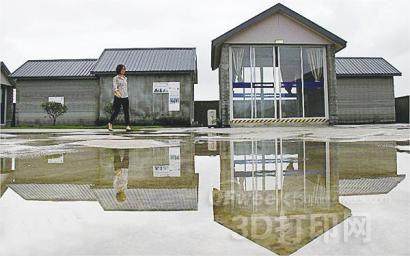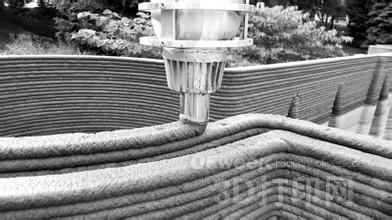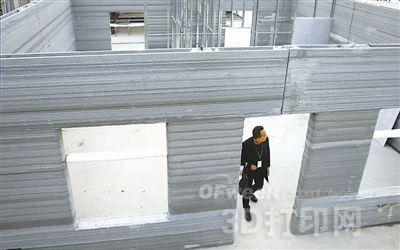In recent years, residential industrialization has developed rapidly under the support of national policies. A number of industrialized residential buildings have emerged, and residential industrialization has entered the fast lane of development, especially the development of information technology, which has promoted the industrialization of housing to automation and integration. And intelligent development. The emergence of 3D printed concrete buildings fully demonstrates the bright prospects for the future industrialization of residential development. The intelligent realization of the construction industry is not a castle in the air. Not long ago, a construction company in Shanghai built two buildings with 3D printers . Shanghai's 1,100-square-meter villa, and the other is a six-story residential building in Suzhou, which is currently the world's tallest 3D printed building .
3D printing technology is an advanced manufacturing technology, and its characteristics that are not limited by product structure determine that it has sufficient use in many industries. From another perspective, 3D printing is just an advanced manufacturing technique and a tool. Its value as a product itself is not high, and it needs to realize value in industrial applications. It is a process in which technical advantages and user needs gradually fit together. For 3D printed concrete buildings, cost, raw materials and structural safety are key points for their future development.
3D printed concrete structure analysis
At present, 3D printing concrete building is to modularize the whole building, print the building industrialization module with 3D printer, and finally transport it to the construction site for assembly. Therefore, the production and construction process is basically the same as the PC component industrialized residence. The difference is that in these 3D printed walls, panels and other modules, there is no steel bar, but the combination of cement and fiberglass is used to improve the tensile strength of the entire concrete structure, thereby realizing the construction of a 6-story residential building with unreinforced concrete structures. .
At present, domestic residential industrialized PC structural systems are divided into two categories, one is a fully assembled structure, and the other is a partially cast-in-place partially assembled structure. For example, Vanke researches and develops the integrated residential structure system, which is actually imported from Japan. Its beams, columns and shear walls are cast-in-place as load-bearing structures; the floor is prefabricated with precast slabs and cast-in-place laminated semi-prefabricated; The exterior walls, stairs, and balconies are all prefabricated components. The fifth-generation integrated home of Yuanda’s migrant workers is similar. Therefore, from the current situation in China, most of them adopt semi-prefabricated structural systems. Only large-scale sustainable buildings adopt fully-assembled steel structures, all of which are bolted and can be connected with 6 layers a day. Various new types of fabricated building structures have also emerged.

3D printing concrete building, as the most advanced technology of residential industrialization, is to break through the semi-prefabricated structure system, adopt the full assembly structure, and even the whole process of 3D printing, can realize the process of completely transforming the construction industry from traditional construction to manufacturing. In addition to the basics, the future even includes the basic use of 3D printing to achieve true intelligent manufacturing and the use of virtual assembly technology. The virtual assembly adopts computer simulation and virtual reality technology, and simulates the simulation on the computer through the simulation model to realize the optimization plan of the process planning, manufacturing and on-site assembly of the product.
For the 3D printed building module, the unreinforced structure is designed to facilitate printing on the one hand, and to achieve the advantages of light, thin and strong 3D printed concrete modules on the other hand, using different types of concrete to print different functions, Structure of the building module. Therefore, 3D printed concrete has a wider range of raw materials and more varieties. The mechanism of coagulation hardening and strength will break through the theoretical scope of traditional concrete. Durability and safety are still to be studied and demonstrated.
As technology continues to evolve, even giant 3D printers will appear in the future, printing the entire building on site, similar to the main structure of a 3D printer with a double gantry style, the printer can be lifted and lowered like a tower crane, and a number of variable position purlins are placed on the top. A print head is arranged on each stringer, and ten to ten print heads are arranged according to the size of the area. The vertical structure of the building can be printed directly on the floor. The modular structural steel bars are hung on the site by cranes for welding assembly. The print head can be sandwiched with steel mesh layers like a tool of ancient rammed earth wall. Stack the concrete. Once this giant printer appears, it will bring huge changes to the entire commercial concrete industry, and it is also a huge challenge for small and medium-sized commercial concrete enterprises. This concrete technology for 3D printing is more complicated and quality. More demanding.

Analysis of raw materials for 3D printed concrete
According to public information, Shanghai 3D printed concrete building is made of glass fiber reinforced concrete, which is characterized by higher tensile, flexural and crack resistance than ordinary concrete, and its toughness and impact resistance are also improved compared with ordinary concrete. It is applied to non-load-bearing components such as building exterior wall panels, ceilings and partition wall panels. For example, the white concrete grid on the exterior of the French pavilion at the Shanghai World Expo is the fiberglass concrete used.
From the current development trend of 3D printed concrete technology, the proportion of ordinary concrete in 3D printed building materials will be greatly reduced in the future, fiber concrete, foam concrete, lightweight aggregate concrete, cement-resin-based concrete, polymer concrete Concrete such as water glass concrete will be used on a larger scale, and even new material concrete may appear.
3D printed concrete is different from traditional concrete. Because 3D printing has no template, it not only needs to meet the requirements of rapid prototyping , that is, it quickly condenses and flows out from the printing nozzle, and it also needs to meet the tight connection between layers of concrete. Instead of creating cold seams, 3D printed concrete components or buildings are seamless; in addition, concrete is allowed to flow freely within the pipe and within the nozzle without clogging the pipes and nozzles. These three points require that 3D printed concrete be different from traditional concrete, and its raw materials and quality requirements are different.

From the point of view of cementitious materials, the cementitious materials used in 3D printed concrete are very wide and are concrete in a broad sense, not ordinary cement concrete. In addition to cement, tree fingers, water glass, gypsum, geopolymers, etc. can be used as a cementing material for 3D printed concrete. The geopolymer is more suitable for 3D printed concrete because of its fast and hard early strength.
Aggregate is the largest proportion of concrete, and 3D printed concrete has higher requirements for aggregate than traditional concrete. Aggregates with high strength, low density and close to spherical shape are most suitable for 3D printed concrete. At the same time, 3D printed concrete buildings are made up of layers of concrete, each layer of concrete is relatively thin, plus The structure of the upper 3D printer nozzle is complicated, so the aggregate size in the concrete is required to be smaller than that of the conventional concrete, and the maximum aggregate size of the aggregate should be below 10 mm. The requirements for particle grading, mud content, and harmful substance content are more stringent. These are all determined by the particularity of 3D printed concrete.
Admixtures account for the smallest proportion of concrete constituent materials, but significantly improve the performance of concrete. 3D printed concrete requires higher working performance, excellent fluidity in the pipeline, and can be in the air after coming out from the nozzle. Rapid coagulation, thus inevitably requiring the admixture to have multiple functions, must be a composite superplasticizer. In addition, the materials used in 3D printing concrete are complex and diverse, and the admixtures are required to have good adaptability, and are used for 3D printing.

The development of residential industrialization and information technology has led to the creation of new architectural forms, which are 3D printed buildings. 3D printing architecture is a very complicated system engineering, which inherits the idea of ​​manufacturing line production and intelligent manufacturing. It completely breaks the restriction that building construction can not adopt industrial production, which provides unlimited possibilities for the industrialization of building. Achieving 3D printed concrete buildings is an inevitable trend of residential industrialization development, a necessary requirement to adapt to the development of modern building technology, and an important way to improve the technical level and technological innovation of the entire construction industry.
The development of 3D printed concrete technology is both an opportunity and an unprecedented challenge for the commercial concrete industry. Only by insisting on technological innovation and keeping up with the trend of building technology development can we win the opportunities in the future commercial concrete market competition and achieve sustained and healthy development.
Making grill shrimp, vegetables, and diced meat more easier and delicious. The professional manufacturing in the barbeque set, our grill top rack are accepted by the world wide market,it can "NET" your color life.Our bbq grill basket have so many type for your necessary that including hamburger grill rack,non-stick painting grill top rack,large capacity bbq grill basket. Certainly, customized is accepted.
Bbq Grill Basket,Grill Basket,Fish Grill Basket,Vegetable Grill Basket
MEO DEMO CO., LTD. , https://www.meokitchenknives.com